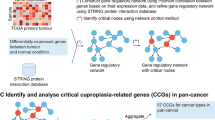Abstract
Background
PLEKHG5, a Rho-specific guanine-nucleotide exchange factor, is involved in tumor cell migration, invasion and angiogenic potential. In this study, the expression pattern, prognostic value and function of PLEKHG5 in gliomas were investigated.
Methods
Immunohistochemistry was used to determine the expression pattern of PLEKHG5 in 61 glioma patients after curative resection. Statistical analysis was performed to evaluate the diagnostic and prognostic significance of PLEKHG5. Gene ontology (GO) analysis, Kyoto encyclopedia of genes and genomes (KEGG) pathway analysis and Gene set enrichment analysis (GSEA) were used to predict potential functions of PLEKHG5. Migration assay and western blot analysis determined PLEKHG5 function in glioma migration and invasion.
Results
Increased PLEKHG5 expression levels were associated with higher glioma grades (P < 0.05). In addition, glioblastomas multiforme have higher ratio and stronger intensity of PLEKHG5 expression compared with low-grade gliomas. High expression level of PLEKHG5 indicated poorer prognosis and shorter survival time in all glioma patients (P < 0.001). GO analysis, KEGG pathway analysis and GSEA analysis suggested that PLEKHG5 was involved in glioma migration, invasion and epithelial–mesenchymal transition. Migration assay and western blot analysis revealed PLEKHG5 promoted glioma migration and invasion.
Conclusion
Our results demonstrated PLEKHG5 could be used as a novel prognostic biomarker and anti-tumor target for glioma patients.





Similar content being viewed by others
References
Ostrom QT, Bauchet L, Davis FG et al (2014) The epidemiology of glioma in adults: a "state of the science" review. Neurooncology 16(7):896–913
Wen PY, Kesari S (2008) Malignant gliomas in adults. N Engl J Med 359(5):492–507
Nagarajan RP, Costello JF (2009) Epigenetic mechanisms in glioblastoma multiforme. Semin Cancer Biol 19(3):188–197
Jhaveri N, Chen TC, Hofman FM (2016) Tumor vasculature and glioma stem cells: contributions to glioma progression. Cancer Lett 380(2):545–551
Nutt CL, Mani DR, Betensky RA et al (2003) Gene expression-based classification of malignant gliomas correlates better with survival than histological classification. Can Res 63(7):1602–1607
Wesseling P, Capper D (2018) WHO 2016 classification of gliomas. Neuropathol Appl Neurobiol 44(2):139–150
Nakada M, Nakada S, Demuth T et al (2007) Molecular targets of glioma invasion. Cell Mol Life Sci CMLS 64(4):458–478
Wang H, Han M, Whetsell W Jr et al (2014) Tax-interacting protein 1 coordinates the spatiotemporal activation of Rho GTPases and regulates the infiltrative growth of human glioblastoma. Oncogene 33(12):1558–1569
Etienne-Manneville S, Hall A (2002) Rho GTPases in cell biology. Nature 420(6916):629–635
Goicoechea SM, Awadia S, Garcia-Mata R (2014) I'm coming to GEF you: regulation of RhoGEFs during cell migration. Cell Adhes Migr 8(6):535–549
De Toledo M, Coulon V, Schmidt S et al (2001) The gene for a new brain specific RhoA exchange factor maps to the highly unstable chromosomal region 1p36.2–1p36.3. Oncogene 20(50):7307–7317
Liu M, Horowitz A (2006) A PDZ-binding motif as a critical determinant of Rho guanine exchange factor function and cell phenotype. Mol Biol Cell 17(4):1880–1887
Ngok SP, Geyer R, Liu M et al (2012) VEGF and angiopoietin-1 exert opposing effects on cell junctions by regulating the Rho GEF Syx. J Cell Biol 199(7):1103–1115
Garnaas MK, Moodie KL, Liu ML et al (2008) Syx, a RhoA guanine exchange factor, is essential for angiogenesis in vivo. Circ Res 103(7):710–716
Dachsel JC, Ngok SP, Lewis-Tuffin LJ et al (2013) The Rho guanine nucleotide exchange factor Syx regulates the balance of dia and ROCK activities to promote polarized-cancer-cell migration. Mol Cell Biol 33(24):4909–4918
Grun D, Adhikary G, Eckert RL (2019) NRP-1 interacts with GIPC1 and SYX to activate p38 MAPK signaling and cancer stem cell survival. Mol Carcinog 58(4):488–499
Arden JD, Lavik KI, Rubinic KA et al (2015) Small-molecule agonists of mammalian diaphanous-related (mDia) formins reveal an effective glioblastoma anti-invasion strategy. Mol Biol Cell 26(21):3704–3718
Roy R, Yang J, Moses MA (2009) Matrix metalloproteinases as novel biomarkers and potential therapeutic targets in human cancer. J Clin Oncol Off J Am Soc Clin Oncol 27(31):5287–5297
Nakada M, Nakamura H, Ikeda E et al (1999) Expression and tissue localization of membrane-type 1, 2, and 3 matrix metalloproteinases in human astrocytic tumors. Am J Pathol 154(2):417–428
Chambers AF, Groom AC, MacDonald IC (2002) Dissemination and growth of cancer cells in metastatic sites. Nat Rev Cancer 2(8):563–572
Nobes CD, Hall A (1995) Rho, rac, and cdc42 GTPases regulate the assembly of multimolecular focal complexes associated with actin stress fibers, lamellipodia, and filopodia. Cell 81(1):53–62
Sahai E, Marshall CJ (2003) Differing modes of tumour cell invasion have distinct requirements for Rho/ROCK signalling and extracellular proteolysis. Nat Cell Biol 5(8):711–719
Tsuji T, Ishizaki T, Okamoto M et al (2002) ROCK and mDia1 antagonize in Rho-dependent Rac activation in Swiss 3T3 fibroblasts. J Cell Biol 157(5):819–830
Acknowledgements
This work was supported by Grants from the National Natural Science Foundation of China (nos. 30872645, 81101594, 81372719, 81172403, 81402077, 81571284, 91542115, 81702468, 81874083, 81802966), National Natural Science Foundation of Shandong Province of China (no. 2017CXGC1203, 2017G006012, 2013GGE27006) and Taishan Scholars of Shandong Province of China (no. ts201511093).
Author information
Authors and Affiliations
Corresponding authors
Ethics declarations
Conflict of interest
The authors declare no conflict of interest.
Research involving human participants and/or animal
Ethical approval for using human samples in this study was obtained from the local ethics committee.
Informed consent
Patients gave consent for the use of their tumor tissues for future investigations, which had been performed for many years at time of the initial diagnosis.
Additional information
Publisher's Note
Springer Nature remains neutral with regard to jurisdictional claims in published maps and institutional affiliations.
Electronic supplementary material
Below is the link to the electronic supplementary material.
About this article
Cite this article
Qian, M., Chen, Z., Wang, S. et al. PLEKHG5 is a novel prognostic biomarker in glioma patients. Int J Clin Oncol 24, 1350–1358 (2019). https://doi.org/10.1007/s10147-019-01503-0
Received:
Accepted:
Published:
Issue Date:
DOI: https://doi.org/10.1007/s10147-019-01503-0




